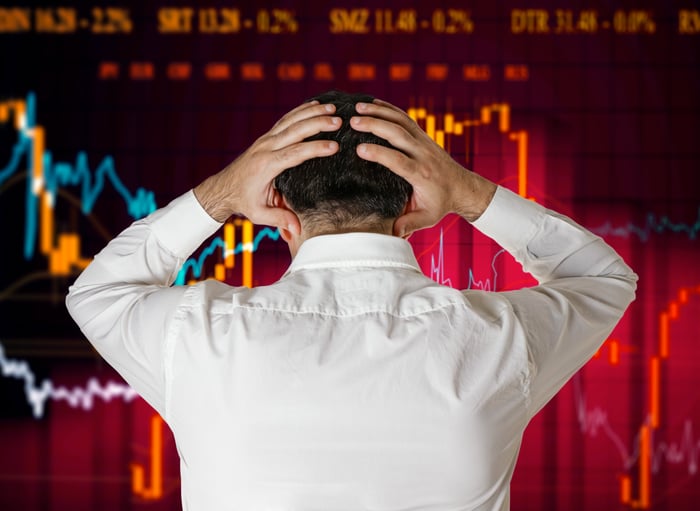We all like to think we'll stay calm and collected the next time the stock market crashes. Better yet, we promise ourselves we won't pass up the opportunity. Instead, we'll invest even more.
But logic doesn't always win when emotions kick in. And it's hard not to panic when a stock market crash temporarily eats up a substantial portion of your wealth. Here are five facts that will help you stop panicking and sleep better next time the market goes south.

Image source: Getty Images.
1. Corrections happen more frequently than you think.
The first thing to remember when you've just lost a ton of money in the market is just how common crashes are. Between 2000 and 2019, a stock market correction (meaning a drop of 10% or more) occurred in 11 out of 20 years. Bear markets, defined as a drop of 20% or more, are less common but also inevitable.
To put things in perspective: Only about 20% of corrections that have occurred since 1974 have led to a bear market, according to the Schwab Center for Financial Research. When a bear market did happen, it only lasted about 17 months.
2. The best days often follow the worst days.
If the stock market just had a terrible day, odds are high that good days are in the near future. A JPMorgan Chase study found that between Jan. 3, 2000, and April 19, 2020, seven of the 10 best days happened within two weeks of the worst days. Five of the best days happened within one week of the worst days.
The effect of panic selling and missing out on just a few of those best days has a huge impact on long-term returns. If you'd invested $10,000 in the S&P 500 index at the beginning of 2000 and left it fully invested for 20 years, your investment would have grown to $32,421. But if you'd missed the 10 best days of the market, that same investment would only be worth $16,180 at the end of 20 years.
3. Average annual returns are about 9% (even including the bad years)
Over the past 40 years, the S&P 500 has delivered pre-inflation average annualized returns just shy of 9%. If all dividends were reinvested, the number goes up to over 11%. That's when you include the Black Monday crash of 1987, the dot-com bubble burst, and the 2008 financial crisis. If you're investing with only short-term goals, there's good reason to be afraid when the market tanks. But when you invest for the long term, the subsequent recoveries and rallies easily erase the crashes.
4. Stocks have made money 73% of the time in any given year.
If you ever hear someone compare the stock market to gambling, tell them that's utter hogwash. Looking back at one-year periods in market history, the S&P 500 index has delivered positive returns 73% of the time. Over a five-year holding period, the odds go up to 87%. And a 10-year holding period has delivered positive returns 94% of the time.
5. The S&P 500's 20-year returns have always been positive.
The most incredible fact about the S&P 500 that should help you sleep soundly tonight is this: At no point in the past 100 years would you have lost money over a 20-year holding period had you invested in the S&P 500. Even if you bought when the market had peaked. Even if you panic-sold right after a crash.
The big lesson: Stay calm, don't engage in panic selling, and keep investing as usual. Historically, a long holding period has always healed the wounds of a stock market crash.




